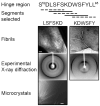β₂-microglobulin forms three-dimensional domain-swapped amyloid fibrils with disulfide linkages
- PMID: 21131979
- PMCID: PMC3058263
- DOI: 10.1038/nsmb.1948
β₂-microglobulin forms three-dimensional domain-swapped amyloid fibrils with disulfide linkages
Abstract
β₂-microglobulin (β₂m) is the light chain of the type I major histocompatibility complex. It deposits as amyloid fibrils within joints during long-term hemodialysis treatment. Despite the devastating effects of dialysis-related amyloidosis, full understanding of how fibrils form from soluble β₂m remains elusive. Here we show that β₂m can oligomerize and fibrillize via three-dimensional domain swapping. Isolating a covalently bound, domain-swapped dimer from β₂m oligomers on the pathway to fibrils, we were able to determine its crystal structure. The hinge loop that connects the swapped domain to the core domain includes the fibrillizing segment LSFSKD, whose atomic structure we also determined. The LSFSKD structure reveals a class 5 steric zipper, akin to other amyloid spines. The structures of the dimer and the zipper spine fit well into an atomic model for this fibrillar form of β₂m, which assembles slowly under physiological conditions.
Figures





Similar articles
-
Domain swapping and amyloid fibril conformation.Prion. 2012 Jul 1;6(3):211-6. doi: 10.4161/pri.18987. Epub 2012 Jul 1. Prion. 2012. PMID: 22437737 Free PMC article.
-
Uncovering the Early Assembly Mechanism for Amyloidogenic β2-Microglobulin Using Cross-linking and Native Mass Spectrometry.J Biol Chem. 2016 Feb 26;291(9):4626-37. doi: 10.1074/jbc.M115.691063. Epub 2015 Dec 10. J Biol Chem. 2016. PMID: 26655720 Free PMC article.
-
Structural Features of Amyloid Fibrils Formed from the Full-Length and Truncated Forms of Beta-2-Microglobulin Probed by Fluorescent Dye Thioflavin T.Int J Mol Sci. 2018 Sep 14;19(9):2762. doi: 10.3390/ijms19092762. Int J Mol Sci. 2018. PMID: 30223436 Free PMC article.
-
The three-dimensional structure of beta2 microglobulin: results from X-ray crystallography.Biochim Biophys Acta. 2005 Nov 10;1753(1):85-91. doi: 10.1016/j.bbapap.2005.07.010. Epub 2005 Jul 27. Biochim Biophys Acta. 2005. PMID: 16084780 Review.
-
Towards an understanding of the structural molecular mechanism of beta(2)-microglobulin amyloid formation in vitro.Biochim Biophys Acta. 2005 Nov 10;1753(1):51-63. doi: 10.1016/j.bbapap.2005.07.006. Epub 2005 Aug 15. Biochim Biophys Acta. 2005. PMID: 16099226 Free PMC article. Review.
Cited by
-
Structural characterization of V57D and V57P mutants of human cystatin C, an amyloidogenic protein.Acta Crystallogr D Biol Crystallogr. 2013 Apr;69(Pt 4):577-86. doi: 10.1107/S0907444912051657. Epub 2013 Mar 14. Acta Crystallogr D Biol Crystallogr. 2013. PMID: 23519666 Free PMC article.
-
Out-of-register β-sheets suggest a pathway to toxic amyloid aggregates.Proc Natl Acad Sci U S A. 2012 Dec 18;109(51):20913-8. doi: 10.1073/pnas.1218792109. Epub 2012 Dec 3. Proc Natl Acad Sci U S A. 2012. PMID: 23213214 Free PMC article.
-
Atomic structures of fibrillar segments of hIAPP suggest tightly mated β-sheets are important for cytotoxicity.Elife. 2017 Jan 3;6:e19273. doi: 10.7554/eLife.19273. Elife. 2017. PMID: 28045370 Free PMC article.
-
Exploration of Insulin Amyloid Polymorphism Using Raman Spectroscopy and Imaging.Biophys J. 2020 Jun 16;118(12):2997-3007. doi: 10.1016/j.bpj.2020.04.031. Epub 2020 May 4. Biophys J. 2020. PMID: 32428440 Free PMC article.
-
Proline Residues as Switches in Conformational Changes Leading to Amyloid Fibril Formation.Int J Mol Sci. 2017 Mar 7;18(3):549. doi: 10.3390/ijms18030549. Int J Mol Sci. 2017. PMID: 28272335 Free PMC article.
References
-
- Westermark P, et al. Amyloid: toward terminology clarification. Report from the Nomenclature Committee of the International Society of Amyloidosis. Amyloid. 2005;12:1–4. - PubMed
-
- Chiti F, Dobson CM. Protein misfolding, functional amyloid, and human disease. Annu Rev Biochem. 2006;75:333–66. - PubMed
-
- Makin OS, Serpell LC. Structures for amyloid fibrils. Febs J. 2005;272:5950–61. - PubMed
-
- Sawaya MR, et al. Atomic structures of amyloid cross-β spines reveal varied steric zippers. Nature. 2007;447:453–7. - PubMed
Publication types
MeSH terms
Substances
Associated data
- Actions
- Actions
Grants and funding
LinkOut - more resources
Full Text Sources
Molecular Biology Databases

